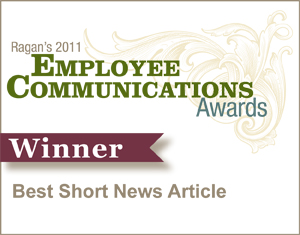A germ of an idea, given time, becomes an infectious story
The 250-word report details the unearthing of a pre-antibiotic-era bacterium in a 19th-century time capsule. Combining drama, science, and history, it goes viral among the staff.
Our winner in “Best Short News Article, the online story “Digging up the past. Literally.” appearing Oct. 12, 2011, in the intranet publication, NYULMC², published by Langone Medical Center at New York University, does a lot of good work in a few column inches:
- The newsletter editors capitalized on the ready-made drama of bacteriological science and manmade evolutionary change to supercharge a developing story in their organization.
- Interest in this time capsule was heightened further by the importance of this time-capsule bacterium to the history of science, that is, the comparison of the old bacterium’s genome to the genome of the modern form of the bacterium in its post -antibiotic phase. What can we learn from it?
- The understated lede of the story fits it exactly right. No need for added excitement or hyperbolic rhetoric. The drama is more than strong enough to stand on its own:
“Last Wednesday afternoon, an event 114 years in the making took place in the lab of Dr. Martin Blaser, chair of the Department of Medicine: the opening of a time capsule.”
- The editors use historical detail in just the right proportions in the rest of the story to sustain interest and build intense reader curiosity for more facts: Who were the “five females” infected by the bacillus, known in l897 as Aerogenes Capsulatus? What was their complaint, or what were their complaints? What were their symptoms? Their fate?
- So many vital themes play into this story: Langone Medical Center’s mission, its commitment to pure science, its research in epidemiology, evolution, and genomic structures, the pathos of the march of medical science, the realization that Langone’s institutional history now encompasses good parts of three different centuries.
- This story isn’t close to being over. There are several good story ideas left:
- How does the old genome of Aerogenes Capsulatus differ from that of its successor, now known as Clostridium perfringens? Is it more or less infectious? More or less lethal? Does it cause the same diseases?
- Who was the doctor/professor, Edward K. Dunham, who planted this time capsule in l897? What did he discover? Where and how did he end his career? How was the capsule lost track of?
- Did the opening of the time capsule make the pages of The Wall Street Journal? (There was a reporter from WSJ present when the capsule was opened.) Did the story travel even further, for example, to Nature, or Scientific American, or JAMA?
We’ll follow the upshot of this fascinating glimpse into Langone’s history. Stay tuned.
To view the winning work please click here.
Editor: Cody Weber
View More Employee Communications Awards 2011 Winners.
Visit Ragan.com/Awards to learn more about awards opportunities.


